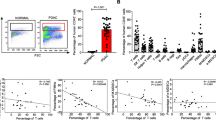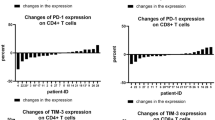Abstract
Elevated levels of myeloid-derived suppressor cells (MDSCs) induced by tumor-derived factors are associated with inhibition of immune responses in patients with gastrointestinal malignancies. We hypothesized that pro-MDSC cytokines and levels of MDSC in the peripheral blood would be elevated in pancreatic adenocarcinoma patients with progressive disease. Peripheral blood mononuclear cells (PBMCs) were isolated from 16 pancreatic cancer patients undergoing chemotherapy and phenotyped for MDSC using a five antigen panel (CD33, HLA-DR, CD11b, CD14, CD15). Patients with stable disease had significantly lower MDSC levels in the peripheral blood than those with progressive disease (1.41 ± 1.12 vs. 5.14 ± 4.58 %, p = 0.013, Wilcoxon test). A cutoff of 2.5 % MDSC identified patients with progressive disease. Patients with ECOG performance status ≥2 had a weaker association with increased levels of MDSC. Plasma was obtained from 15 chemonaive patients, 13 patients undergoing chemotherapy and 9 normal donors. Increases in the levels of pro-MDSC cytokines were observed for pancreatic cancer patients versus controls, and the pro-MDSC cytokine IL-6 was increased in those patients undergoing chemotherapy. This study suggests that MDSC in peripheral blood may be a predictive biomarker of chemotherapy failure in pancreatic cancer patients.




Similar content being viewed by others
Abbreviations
- CCL5:
-
Chemokine (C-C motif) ligand 5 [synonym: RANTES]
- CD:
-
Cluster of differentiation
- CT:
-
Computerized tomography
- FGF2:
-
Basic fibroblast growth factor
- FOLFIRINOX:
-
Chemotherapy consisting of 5-FU, leucovorin, irinotecan and oxaliplatin
- G-CSF:
-
Granulocyte colony-stimulating factor
- HLA:
-
Human leukocyte antigen
- IPA:
-
Ingenuity pathway analysis
- MCP-1:
-
Monocyte chemotactic protein 1
- MDSC:
-
Myeloid-derived suppressor cell
- MIP-1α:
-
Macrophage inflammatory protein-1alpha
- MPACT:
-
Metastatic pancreatic adenocarcinoma clinical trial
- PBMC:
-
Peripheral blood mononuclear cell
- PDGF-bb:
-
Platelet-derived growth factor–beta
- RAGE:
-
Receptor for advanced glycation endproducts
- RANTES:
-
Regulated on activation, normal T cell expressed and secreted [synonym: CCL5]
- STAT3/SOC3:
-
Signal transducer and activator of transcription 3/suppressor of cytokine signaling 3
References
Siegel R, Naishadham D, Jemal A (2013) Cancer statistics, 2013. CA Cancer J Clin 63(1):11–30. doi:10.3322/caac.21166
Conroy T, Desseigne F, Ychou M, Bouche O, Guimbaud R, Becouarn Y, Adenis A, Raoul JL, Gourgou-Bourgade S, de la Fouchardiere C, Bennouna J, Bachet JB, Khemissa-Akouz F, Pere-Verge D, Delbaldo C, Assenat E, Chauffert B, Michel P, Montoto-Grillot C, Ducreux M (2011) FOLFIRINOX versus gemcitabine for metastatic pancreatic cancer. N Engl J Med 364(19):1817–1825. doi:10.1056/NEJMoa1011923
Kim R (2011) FOLFIRINOX: a new standard treatment for advanced pancreatic cancer? Lancet Oncol 12(1):8–9. doi:10.1016/S1470-2045(10)70237-0
Ying JE, Zhu LM, Liu BX (2012) Developments in metastatic pancreatic cancer: Is gemcitabine still the standard? World J Gastroenterol 18(8):736–745. doi:10.3748/wjg.v18.i8.736
Kothari N, Saif MW, Kim R (2013) First-line treatment for advanced pancreatic cancer. JOP 14(2):129–132. doi:10.6092/1590-8577/1477
Patel J (2013) Drug combination extends late-stage pancreatic cancer survival in phase III clinical trial. Expert Rev Clin Pharmacol 6(2):100
DeNardo DG, Brennan DJ, Rexhepaj E, Ruffell B, Shiao SL, Madden SF, Gallagher WM, Wadhwani N, Keil SD, Junaid SA, Rugo HS, Hwang ES, Jirstrom K, West BL, Coussens LM (2011) Leukocyte complexity predicts breast cancer survival and functionally regulates response to chemotherapy. Cancer Discov 1(1):54–67. doi:10.1158/2159-8274.CD-10-0028
Gajewski TF, Schreiber H, Fu YX (2013) Innate and adaptive immune cells in the tumor microenvironment. Nat Immunol 14(10):1014–1022. doi:10.1038/ni.2703
Jarboe J, Gupta A, Saif W (2014) Therapeutic human monoclonal antibodies against cancer. Methods Mol Biol 1060:61–77. doi:10.1007/978-1-62703-586-6_4
Drake CG (2012) Combination immunotherapy approaches. Ann Oncol 23(Suppl 8):viii41–viii46. doi:10.1093/annonc/mds262
Clark CE, Hingorani SR, Mick R, Combs C, Tuveson DA, Vonderheide RH (2007) Dynamics of the immune reaction to pancreatic cancer from inception to invasion. Cancer Res 67(19):9518–9527. doi:10.1158/0008-5472.CAN-07-0175
Evans A, Costello E (2012) The role of inflammatory cells in fostering pancreatic cancer cell growth and invasion. Front Physiol 3:270. doi:10.3389/fphys.2012.00270
Gabrilovich DI, Ostrand-Rosenberg S, Bronte V (2012) Coordinated regulation of myeloid cells by tumours. Nat Rev Immunol 12(4):253–268. doi:10.1038/nri3175
Mundy-Bosse BL, Young GS, Bauer T, Binkley E, Bloomston M, Bill MA, Bekaii-Saab T, Carson WE 3rd, Lesinski GB (2011) Distinct myeloid suppressor cell subsets correlate with plasma IL-6 and IL-10 and reduced interferon-alpha signaling in CD4(+) T cells from patients with GI malignancy. Cancer Immunol Immunother 60(9):1269–1279. doi:10.1007/s00262-011-1029-z
Gabitass RF, Annels NE, Stocken DD, Pandha HA, Middleton GW (2011) Elevated myeloid-derived suppressor cells in pancreatic, esophageal and gastric cancer are an independent prognostic factor and are associated with significant elevation of the Th2 cytokine interleukin-13. Cancer Immunol Immunother 60(10):1419–1430. doi:10.1007/s00262-011-1028-0
Zhao F, Obermann S, von Wasielewski R, Haile L, Manns MP, Korangy F, Greten TF (2009) Increase in frequency of myeloid-derived suppressor cells in mice with spontaneous pancreatic carcinoma. Immunology 128(1):141–149. doi:10.1111/j.1365-2567.2009.03105.x
Porembka MR, Mitchem JB, Belt BA, Hsieh CS, Lee HM, Herndon J, Gillanders WE, Linehan DC, Goedegebuure P (2012) Pancreatic adenocarcinoma induces bone marrow mobilization of myeloid-derived suppressor cells which promote primary tumor growth. Cancer Immunol Immunother 61(9):1373–1385. doi:10.1007/s00262-011-1178-0
Duffy MJ, Sturgeon C, Lamerz R, Haglund C, Holubec VL, Klapdor R, Nicolini A, Topolcan O, Heinemann V (2010) Tumor markers in pancreatic cancer: a European Group on Tumor Markers (EGTM) status report. Ann Oncol 21(3):441–447. doi:10.1093/annonc/mdp332
Solito S, Falisi E, Diaz-Montero CM, Doni A, Pinton L, Rosato A, Francescato S, Basso G, Zanovello P, Onicescu G, Garrett-Mayer E, Montero AJ, Bronte V, Mandruzzato S (2011) A human promyelocytic-like population is responsible for the immune suppression mediated by myeloid-derived suppressor cells. Blood 118(8):2254–2265. doi:10.1182/blood-2010-12-325753
Ruiz-Tovar J, Martin-Perez E, Fernandez-Contreras ME, Reguero-Callejas ME, Gamallo-Amat C (2011) Identification of prognostic factors in pancreatic cancer. Cir Cir 79(4):313–322
Markowitz J, Carson WE (1835) 3rd (2013) Review of S100A9 biology and its role in cancer. Biochim Biophys Acta 1:100–109. doi:10.1016/j.bbcan.2012.10.003
Cheng P, Corzo CA, Luetteke N, Yu B, Nagaraj S, Bui MM, Ortiz M, Nacken W, Sorg C, Vogl T, Roth J, Gabrilovich DI (2008) Inhibition of dendritic cell differentiation and accumulation of myeloid-derived suppressor cells in cancer is regulated by S100A9 protein. J Exp Med 205(10):2235–2249. doi:10.1084/jem.20080132
Turovskaya O, Foell D, Sinha P, Vogl T, Newlin R, Nayak J, Nguyen M, Olsson A, Nawroth PP, Bierhaus A, Varki N, Kronenberg M, Freeze HH, Srikrishna G (2008) RAGE, carboxylated glycans and S100A8/A9 play essential roles in colitis-associated carcinogenesis. Carcinogenesis 29(10):2035–2043. doi:10.1093/carcin/bgn188
Gebhardt C, Riehl A, Durchdewald M, Nemeth J, Furstenberger G, Muller-Decker K, Enk A, Arnold B, Bierhaus A, Nawroth PP, Hess J, Angel P (2008) RAGE signaling sustains inflammation and promotes tumor development. J Exp Med 205(2):275–285. doi:10.1084/jem.20070679
Bjork P, Bjork A, Vogl T, Stenstrom M, Liberg D, Olsson A, Roth J, Ivars F, Leanderson T (2009) Identification of human S100A9 as a novel target for treatment of autoimmune disease via binding to quinoline-3-carboxamides. PLoS Biol 7(4):e97. doi:10.1371/journal.pbio.1000097
Lesina M, Kurkowski MU, Ludes K, Rose-John S, Treiber M, Kloppel G, Yoshimura A, Reindl W, Sipos B, Akira S, Schmid RM, Algul H (2011) Stat3/Socs3 activation by IL-6 transsignaling promotes progression of pancreatic intraepithelial neoplasia and development of pancreatic cancer. Cancer Cell 19(4):456–469. doi:10.1016/j.ccr.2011.03.009
Mace TA, Ameen Z, Collins A, Wojcik S, Mair M, Young GS, Fuchs JR, Eubank TD, Frankel WL, Bekaii-Saab T, Bloomston M, Lesinski GB (2013) Pancreatic cancer-associated stellate cells promote differentiation of myeloid-derived suppressor cells in a STAT3-dependent manner. Cancer Res 73(10):3007–3018. doi:10.1158/0008-5472.CAN-12-4601
Vernon PJ, Loux TJ, Schapiro NE, Kang R, Muthuswamy R, Kalinski P, Tang D, Lotze MT, Zeh HJ 3rd (2013) The receptor for advanced glycation end products promotes pancreatic carcinogenesis and accumulation of myeloid-derived suppressor cells. J Immunol 190(3):1372–1379. doi:10.4049/jimmunol.1201151
Vernon PJ, Zeh Iii HJ, Lotze MT (2013) The myeloid response to pancreatic carcinogenesis is regulated by the receptor for advanced glycation end-products. Oncoimmunology 2(5):e24184. doi:10.4161/onci.24184
Goedegebuure P, Mitchem JB, Porembka MR, Tan MC, Belt BA, Wang-Gillam A, Gillanders WE, Hawkins WG, Linehan DC (2011) Myeloid-derived suppressor cells: general characteristics and relevance to clinical management of pancreatic cancer. Curr Cancer Drug Targets 11(6):734–751
Bayne LJ, Beatty GL, Jhala N, Clark CE, Rhim AD, Stanger BZ, Vonderheide RH (2012) Tumor-derived granulocyte-macrophage colony-stimulating factor regulates myeloid inflammation and T cell immunity in pancreatic cancer. Cancer Cell 21(6):822–835. doi:10.1016/j.ccr.2012.04.025
Ghansah T, Vohra N, Kinney K, Weber A, Kodumudi K, Springett G, Sarnaik AA, Pilon-Thomas S (2013) Dendritic cell immunotherapy combined with gemcitabine chemotherapy enhances survival in a murine model of pancreatic carcinoma. Cancer Immunol Immunother 62(6):1083–1091. doi:10.1007/s00262-013-1407-9
Annels NE, Shaw VE, Gabitass RF, Billingham L, Corrie P, Eatock M, Valle J, Smith D, Wadsley J, Cunningham D, Pandha H, Neoptolemos JP, Middleton G (2014) The effects of gemcitabine and capecitabine combination chemotherapy and of low-dose adjuvant GM-CSF on the levels of myeloid-derived suppressor cells in patients with advanced pancreatic cancer. Cancer Immunol Immunother 63(2):175–183. doi:10.1007/s00262-013-1502-y
Bunt SK, Mohr AM, Bailey JM, Grandgenett PM, Hollingsworth MA (2013) Rosiglitazone and Gemcitabine in combination reduces immune suppression and modulates T cell populations in pancreatic cancer. Cancer Immunol Immunother 62(2):225–236. doi:10.1007/s00262-012-1324-3
Chinnasamy D, Yu Z, Kerkar SP, Zhang L, Morgan RA, Restifo NP, Rosenberg SA (2012) Local delivery of interleukin-12 using T cells targeting VEGF receptor-2 eradicates multiple vascularized tumors in mice. Clin Cancer Res 18(6):1672–1683. doi:10.1158/1078-0432.CCR-11-3050
Huang C, Huang R, Chang W, Jiang T, Huang K, Cao J, Sun X, Qiu Z (2012) The expression and clinical significance of pSTAT3, VEGF and VEGF-C in pancreatic adenocarcinoma. Neoplasma 59(1):52–61. doi:10.4149/neo_2012_007
Taeger J, Moser C, Hellerbrand C, Mycielska ME, Glockzin G, Schlitt HJ, Geissler EK, Stoeltzing O, Lang SA (2011) Targeting FGFR/PDGFR/VEGFR impairs tumor growth, angiogenesis, and metastasis by effects on tumor cells, endothelial cells, and pericytes in pancreatic cancer. Mol Cancer Ther 10(11):2157–2167. doi:10.1158/1535-7163.MCT-11-0312
Assifi MM, Hines OJ (2011) Anti-angiogenic agents in pancreatic cancer: a review. Anticancer Agents Med Chem 11(5):464–469
Provenzano PP, Cuevas C, Chang AE, Goel VK, Von Hoff DD, Hingorani SR (2012) Enzymatic targeting of the stroma ablates physical barriers to treatment of pancreatic ductal adenocarcinoma. Cancer Cell 21(3):418–429. doi:10.1016/j.ccr.2012.01.007
Bruchard M, Mignot G, Derangere V, Chalmin F, Chevriaux A, Vegran F, Boireau W, Simon B, Ryffel B, Connat JL, Kanellopoulos J, Martin F, Rebe C, Apetoh L, Ghiringhelli F (2013) Chemotherapy-triggered cathepsin B release in myeloid-derived suppressor cells activates the Nlrp3 inflammasome and promotes tumor growth. Nat Med 19(1):57–64. doi:10.1038/nm.2999
Sanford DE, Belt BA, Panni RZ, Mayer A, Deshpande AD, Carpenter D, Mitchem JB, Plambeck-Suess SM, Worley LA, Goetz BD, Wang-Gillam A, Eberlein TJ, Denardo DG, Goedegebuure SP, Linehan DC (2013) Inflammatory monocyte mobilization decreases patient survival in pancreatic cancer: a role for targeting the CCL2/CCR2 axis. Clin Cancer Res 19(13):3404–3415. doi:10.1158/1078-0432.CCR-13-0525
Acknowledgments
We would like to acknowledge National Institute of Health grant T32CA090223 (William Edgar Carson, III) and the Pelotonia Postdoctoral Fellowship (to J. Markowitz). Taylor Brooks was supported by the Pelotonia undergraduate fellowship program. Any opinions, findings and conclusions expressed in this material are those of the author(s) and do not necessarily reflect those of the Pelotonia Fellowship Program. We would also like to acknowledge the National Cancer Institute grant P01CA095426.
Conflict of interest
The authors declare that they have no conflict of interest.
Author information
Authors and Affiliations
Corresponding author
Electronic supplementary material
Below is the link to the electronic supplementary material.
Rights and permissions
About this article
Cite this article
Markowitz, J., Brooks, T.R., Duggan, M.C. et al. Patients with pancreatic adenocarcinoma exhibit elevated levels of myeloid-derived suppressor cells upon progression of disease. Cancer Immunol Immunother 64, 149–159 (2015). https://doi.org/10.1007/s00262-014-1618-8
Received:
Accepted:
Published:
Issue Date:
DOI: https://doi.org/10.1007/s00262-014-1618-8




